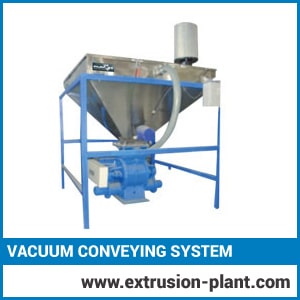Vacuum conveying system are available with varied options at Prime Margo. It is used t feed storage silos. It is used to convey the mixture or blend for the further processing. Our hopper loader vacuum conveying system are built to make suitable with extruder output capacity.
Vacuum Conveying System Manufacturer
Conveyor is available with two options. Spiral conveyor and screw conveyor. The system is provided with level probe to indicate the completion of the material in the silo. PLC based operating system made it too efficient and precise.
Feeding valve is provided with pneumatically operated facility. Feeding valve is used to feed material at hopper of the extruder. It is provided with auto reverse cleaning arrangement for filter. It is mounted on hopper of the extruder, Vacuum Conveying System, Vacuum calibration tank, Vacuum Conveying Systems, Vacuum calibration tanks, Manufacturer, Exporter, Supplier India, Gujarat.
Pneumatic conveying systems are specifically designed to hold a stream of air and a bulk solid material mixture.

What is a Vacuum Conveying System?
A Vacuum Conveying System is a type of material handling device used to transport bulk materials including powders, particle, and pellets through pipelines the use of vacuum pressure. It is generally used in industries like plastics, pharmaceuticals, chemical substances, and food processing where smooth, green, and automatic transfer of substances is important.
- How It Works :- The system uses a vacuum pump or blower to create terrible pressure interior a sealed conveying line. This vacuum draws the material from a storage field (like a silo, hopper, or bag) and movements it through tubing or piping to a receiving vessel, commonly a dosing or mixing unit.
A Vacuum Conveying System gives a easy, efficient, and automatic way to transport bulk materials—making it an critical part of modern-day material dealing with in lots of industries.
Key Advantages
- Dust Free Operation: Maintains a clean environment, especially for sensitive materials
- Closed System: Prevents defect and material loss
- Space-Saving: Ideal for vertical or complex layouts
- Automated Feeding: Reduces manual labor and increases efficiency
- Energy Efficient: Consumes less power compared to other conveying methods

